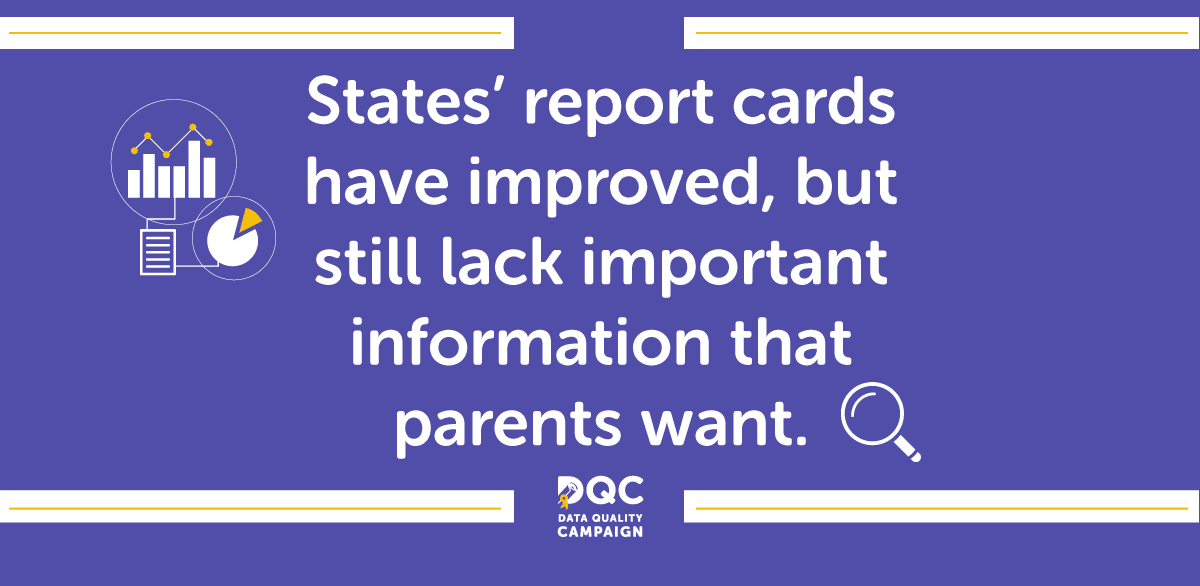Empowering the public with high-quality education data is a continuous improvement project, not a one-time task. We know that state leaders have already invested in the creation and design of their most public-facing resource: their state report card. The findings from DQC’s 2019 public opinion research reinforce the value of these investments and provide further insight into the steps state leaders can take to make report cards a more meaningful tool for families and communities.
States’ investments are leading more parents to look at report cards than ever before.
In 2018, only 58 percent of parents agreed to having looked at a school or district report card in the 12 months prior. Forty percent of those same parents stated this was in part because they didn’t know these resources existed. State leaders responded to these findings with investments that made it easier for parents to find, access, and use report cards. Our 2019 Show Me the Data report found these actions led to big improvements, with 31 states offering mobile-friendly formats and 36 providing downloadable data. These changes were not lost on parents, with even more – 74 percent in 2019 – reporting that they looked at a school or district report card in the past 12 months. This significant increase should encourage state leaders to continue to build on the improvements they’ve made and meet the information demands of families.
State leaders don’t need to look far to learn what data parents still want from report cards.
Parents want a variety of information to help them better understanding the quality and performance of their child’s school. Here’s what parents told us they want states to provide:
- Data that goes beyond how the school is serving all students generally. Eighty-one percent of parents are interested in having access to information about how their child’s school educates students like theirs. A majority of Black parents (60 percent) agreed. Disaggregating student performance data on report cards is more than an ESSA requirement, this information empowers parents to see and engage leaders in how different student groups – including race, gender, and socio-economic status – are performing academically. Despite this demand and federal requirement, 41 states still do not disaggregate the data on their report cards by at least one federally required student group.
- Data that shows growth in how students are learning overtime. Many parents prioritize student growth as a key indicator of school quality when selecting a school for their child. Data on student academic growth helps families and communities better understand how students are progressing in school with the support of teachers and administrators. Unfortunately, our Show Me the Data research revealed that 12 states still don’t publish this information in their report cards, despite 10 of these states using growth data to hold schools accountable.
- Data on school spending. ESSA requires states begin to publish school-level financial data on report cards in the coming year. This is a big departure from the district-level data that was previously required and many states are working to tackle how this data will be made publicly available. It’s important that state leaders recognize the power of school-spending data, especially when shared side-by-side with student outcome data, in answering questions about how education investments are paying off. As one parent in our San Francisco focus group stated, “You want to know where your money goes.”
- Data that shows students are receiving an education that prepares them for life beyond K–12. Parents are their child’s greatest advocates and they know that successful outcomes are tied to more than just K–12 education. Our research shows parents rank information on the number of students who successfully transition into the workforce after high school as one of the top five points that should be included in state report cards. This demand also came across in our 2019 poll, with 84 percent of parents expressing support for their state connecting K–12 education data (like course enrollment) with college data and employment data to understand how students progress through their education and into the workforce.
State leaders have already made huge strides in making report cards a more meaningful tool for parents and communities, but there is still more work to do. Many state report cards still lack the data that matters most to families and fail to paint a full picture of how schools are serving the needs of every child. Parents have spoken and made clear what data they need to best support their children and state leaders are well-positioned to meet these demands. For more information on the actions state leaders must take, explore DQC’s ESSA resource page.
This blog post is also available as a story on Medium.


